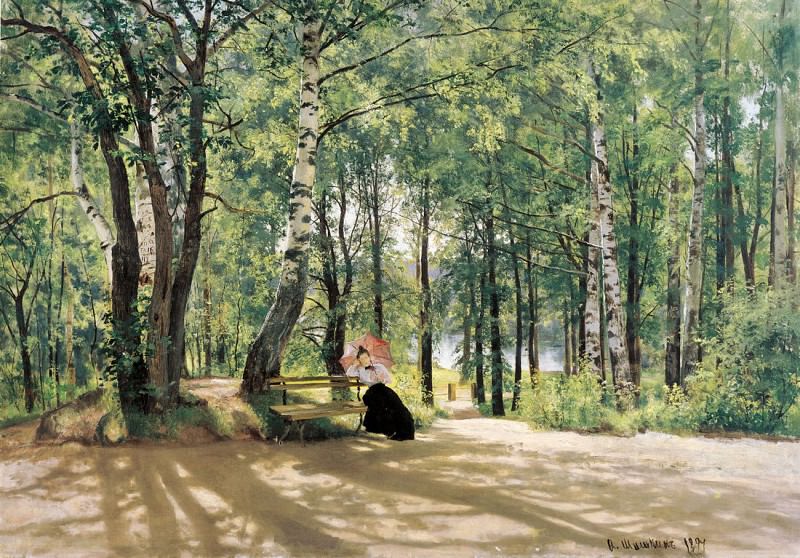In the country (about giving). 1894, 73 5h105, 5 Ivan Ivanovich Shishkin (1832-1898)
Ivan Ivanovich Shishkin – In the country (about giving). 1894, 73 5h105, 5
Edit attribution
Download full size: 1100×767 px (0,3 Mb)
Painter: Ivan Ivanovich Shishkin
Ivan Ivanovich Shishkin was very fond of depicting forests and rivers. Here too, in this painting, painted by the artist in 1894, the viewer is presented with an immersion in the natural world with a luminous range of tones. The whole picture is permeated with air and color. Here one can feel the joy of being, a soft intimate lyrical beginning. The girl puts the book aside and listens enchantingly to the birds singing.
Description of Ivan Shishkin’s painting "At the Dacha"
Ivan Ivanovich Shishkin was very fond of depicting forests and rivers. Here too, in this painting, painted by the artist in 1894, the viewer is presented with an immersion in the natural world with a luminous range of tones. The whole picture is permeated with air and color.
Here one can feel the joy of being, a soft intimate lyrical beginning. The girl puts the book aside and listens enchantingly to the birds singing. It is clear that she is in no hurry. She just went out into the garden to read another novel. In the whole picture you can see the penetration of soft sunlight and tranquility.
The master purposely left no dark spots, so that the viewer could feel the coolness of the leaves on this hot summer afternoon. Painting the landscape was conceived by the artist in light colors, so that the viewer, like himself, perceived nature as something magical and subtle.
The image of the girl with a colored umbrella in her hands, with which she covers herself from the sunlight, her snow-white blouse, her relaxed pose suggest that nothing can interfere with her unity with nature.
The artist purposely depicted a mixed forest, because in the background you can see the smooth surface of the calm river, from which you can feel the coolness due to the light breeze. In the picture the master depicted the mighty trees to his own liking. Their crowns seem to protect the girl from the scorching sun, though the rays of the sun try to penetrate through the dense foliage.
The year of 1895 was marked for Ivan Ivanovich Shishkin by the publication of his fourth album, which contained 60 sheets of his best works.
This painting is so light that the Kazan audience, when Shishkin in 1898 presented this picture to residents of Kazan, asked the master to leave this painting to the city. The artist loved his native Kazan land and did everything possible for it. Many drawings, albums with his works, paintings were passed by him to the art school. During the war they were preserved in the local Kazan museum.
Кому понравилось
Пожалуйста, подождите
На эту операцию может потребоваться несколько секунд.
Информация появится в новом окне,
если открытие новых окон не запрещено в настройках вашего браузера.
You need to login
Для работы с коллекциями – пожалуйста, войдите в аккаунт (open in new window).




















COMMENTS: 1 Ответы
Очень красивое место!!!
You cannot comment Why?
The subtexts of the painting can be interpreted in several ways. The title, In the country (about giving), is particularly intriguing. One possible interpretation of giving could relate to natures generosity – the lush greenery, the sunlight filtering through the leaves, and the peaceful atmosphere can be seen as a gift from the natural world. The presence of the figures enjoying this idyllic setting reinforces this idea of receiving and appreciating natures bounty.
Another layer of meaning might be found in the interaction between the figures. Are they sharing a moment of quiet companionship? Is the woman a mother figure, shielding the other person with the umbrella, symbolizing protection and care? The contrast between the womans lighter attire under the umbrella and the dark covering of the other figure might suggest different states or roles within their relationship.
The overall mood is contemplative and peaceful, evoking a sense of escape from the hustle and bustle of urban life into the tranquility of nature. The play of light and shadow on the sandy path adds depth and dynamism, hinting at the passage of time or shifting moods. The painting invites the viewer to pause, observe, and perhaps reflect on the simple joys and unspoken connections found in a quiet moment in nature.